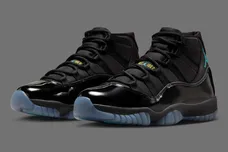Much has been made of Gus Åhr, known professionally as Lil Peep, and his brief career. Many a writer have waxed poetic about his blossoming talent and the way that he established a new musical vocabulary that blended elements of trap, emo, and rock to create a sound that didn’t fit comfortably within the confines of any one genre. “I grew up listening to a lot of emo music, a lot of rock music, a lot of rap music, a lot of trap music, funk, everything," said Peep in an interview with XXL. "One of my favorite hip-hop artists is [ILoveMakonnen]. One of my favorite bands is Fall Out Boy. You put those two together and that’s Lil Peep.”
This fluidity carried over into his role as a revolutionary cultural icon: he doled out power ballads and sweet-nothings that triggered the unlikely resurgence of rap rock at a time when such a sound seemed largely incongruous to the contemporary musical landscape. Come Over When You’re Sober, Pt. 1, the masterful pop-punk album that dropped just a few short months before he passed, had a resounding impact that was felt far beyond its relative commercial success. Peep was the new face of emo, an ascendant pop star poised for immense fame beyond the musical realm. He told Pitchfork in 2017, “In a couple of years, I’ll be a household name. Everyone’s going to know who I am.”
It is this raw, unbound potential that makes Peep’s death all the more heart-wrenching. Immediately following his death, the prospect of revisiting his songs, full of suicidal ideation and substance abuse, felt grim. Picking through the deceased’s thoughts and emotions in an attempt to make sense of their life may serve the living, but more often than not doesn’t yield any moments of clairvoyance beyond the profound sadness that accompanies loss. Thus emerged the issue of what to do with his music, a somber reminder that hung heavy on those tasked with shepherding his legacy. Peep’s mother, Liza Womack, recalled visiting an Apple store with the laptop that her son used to record, and telling an employee, “My son died. This is him. Take this and put it on a new one.”
The contents that were unearthed, lo-fi, ethereal recordings of the same ilk that Peep made almost exclusively in his bedroom, were endured by the close friends and collaborators responsible for piecing together Come Over When You’re Sober, Pt. 2. The album’s defining formula, one that seemed destined to push Peep past the one-off SoundCloud sensations that were deemed his peers, highlights the devotion of the final result. Speaking with Complex, Smokeasac, who oversaw the creation of the album with the help of industry veteran George Astasio, remembered feeling as if Peep was guiding him through the entire process. “He was there with me the whole time I was doing the production,” Smokeasac said. “Even to this day I feel his energy around me…I would get goosebumps, and I literally felt like he was standing behind my back watching me (make the record.)”
There’s no way of knowing how each song would have sounded exactly had Peep still been alive during the recording process, or if the finished product would have withstood his exacting gaze. But Peep’s words, carefully placed directly in the center of the listener’s mind, ring true. Even if COWYS2 is markedly cleaner sounding than much of his previous output, it stands as an example of how to respectfully handle the work of someone who’s no longer around to hear it. Peep’s mother said it best: “This is the album (Gus) would have made if he were living.”
In this respect, COWYS2 picks up right where Peep left off, his music slowly pulling him closer to the stardom and national attention that was seemingly just around the corner. The cinematic touches, accentuated by Peep’s ear for maddeningly simple melodies, are as present as ever, seeping through the dysphoria of each track. Peep’s dynamic half-sighing, half-moaning vocal performances remain unfiltered: his voice fluctuates between drowsy mumbles and scraggly, full-lunged howls, while his attitude occasionally borders on almost laughable boredom.
Yet as a whole, COWYS2 is some of the darkest, most emotionally fraught music of Peep’s discography. Gone are the soaring goth rock anthems and delicate indie samples, replaced by tense guitar riffs and reverberating hip hop percussion. Familiar themes of depression and drug use receive an all-consuming encore, while the moments of hope and joy present on prior releases are fleeting. The uplifting slivers that do shine through are chiefly on “Falling Down,” Peep’s highest charting song that came out of the recording sessions he had with iLoveMakonnen. XXXTentacion, who makes an appearance on the track, is the lone feature on an album bereft of the usual head-turning, last minute tag-ons. Peep’s voice drifts solo beneath the spotlight for the entirety of the 45-minute affair, a welcome act of preservation that also offers bone-chilling reminders of his absence.
The finality of death is barely kept at bay hearing Peep’s voice on opening track “Broken Smile (My All).” With an intro taken from Peep’s verse on Craig Xen’s “UNBREAKABLE,” the song plunges into a plodding steel drum pattern that captures Peep’s feelings of emptiness (“I gotta go right now, that’s all/Nothing to it, don’t expect no call”). The alt-rock guitar and chorus that follow are swept away in melancholy, as he ponders his loneliness. “Runaway” feels even more isolated in Peep’s desperate attempts to escape his problems, namely the fake people who pretend to care but only end up causing him more pain. The haunting repetition of “I was dying and nobody was there” is unnerving to the core, and ties into an interview with Pitchfork in which he calmly stated, “Some days I wake up and I’m like, ‘fuck, I wish I didn’t wake up.’” On newly mixed fan favorite “Sex With My Ex,” Peep’s intonations of “Fuck me like we’re lying on our deathbed” seem to illustrate that he’s strikingly aware of the apparent ludicrous nature of his suffering (in the same Montreality video where he laughed at the idea of living to the age of 86, he mentioned that “there’s almost like a sober me inside the fucked up me, just being like ‘you’re fine, bro’”). A radiant guitar and death rattle usher in Peep’s vocals on “Cry Alone,” as he bemoans his hometown and ponders burning his old high school “into the ground.”
Peep’s cavalier attitude toward death and drugs is the driving force of much of the album, but it is especially prominent on “Leanin’,” a track on which he sounds more indifferent than relieved to have woken up after surviving an overdose (“Woke up surprised/Am I really alive?/I was tryin’ to die last night, survived suicide last night”). The double entendre of “16 Lines” and the way that it unpacks Peep’s notion of dependency is intoxicating (the blurry-eyed metaphors for cocaine carry over to “White Girl”). His observation of “I wonder who you’ll fuck when I die” feels hopelessly empty, especially when tailed by the harrowing refrain of, “Is anybody out there?/Can anybody hear me?”
The album’s focal point, “Life Is Beautiful,” delivers an ironic reflection of life through a series of snapshots that cut deeper as the song progresses (“And if I try suicide, would you stop me?... I think I’ma die alone inside my room”). Chronic illness, police brutality, and the various misfortunes that impact the lives of loved ones are the focus of Peep’s weary message, as he weaves through his suicidal tendencies with a wry and devastating sense of humor (“When I die, I’ll pack my bags, move somewhere more affordable”).
On “Hate Me,” Peep can’t seem to shake his feelings of inadequacy, and reiterates that he doesn’t pick up the phone because “I ain’t ever asked no one for help” (“Star Shopping”). The stunning guitar lick of “IDGAF,” which evokes Metallica’s “The Unforgiven,” presents Peep’s music as a vital extension of himself, before he dives right back into his guilty conscience and self-deprecating disbelief of worth on “Fingers” (“Everyone hates me, but nobody knows me”). His fixation on his own death and sense of his mortality, embodied by the cries of “I’m not gonna last here, I’m not gonna last long,” are disturbing in their premonitions.
Anti-Peep takes continue to dominate social media. In the year since his accidental overdose last fall while on tour, Peep has frequently been misused as a headline for drug abuse by those who saw the face tattoos and troubling life choices and assumed he was something he was not. For critics who crafted pretentious, lowbrow comparisons to aid their claims that Peep’s music was exaggerated posturing, his career represented a moment of generational alienation.
But the ignorant and unconstructive criticism of a young artist who was clearly depressed functions as nothing more than speculative gossip that is a disservice to Peep’s memory. Beneath his angsty teenage poetry, genuine and confessional in its dealings with death, drugs, depression, and heartbreak, was a charming innocence. When asked why he got “crybaby” tattooed on his face, Peep replied that it was a reminder to be “grateful for the shit I do have.”
COWYS2 echoes this contradiction in that it is so much more than just a meditation on death. Gus never shied away from his feelings. He spoke candidly about the demons that hounded him, and though he envisioned his death in numerous songs and likely realized that he was hurtling toward oblivion, it does not mean that he wanted to die. He had no illusions about the dangers of his lifestyle or where they were potentially leading him. He was never complacent; he used his art to claim his pain and seek but a moment’s respite from the world around him and what ate away at him within. Though the ominous thematic nature of Gus' creations is at times emotionally exhausting, it resonates through his talent as a singer-songwriter. Indelible entries such as “Cry Alone,” “Life is Beautiful,” and “Fingers” strengthen the fragile canon of his career, and speak to what’s in our hearts and our heads, the very essence of human existence. He comforted a swelling legion of fans who latched on to his clarity and courage to peer into the void. His music provides a sanctuary and outlet for those dealing with many of the same ailments. “It’s there to let people know they’re not alone,” he said.







